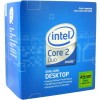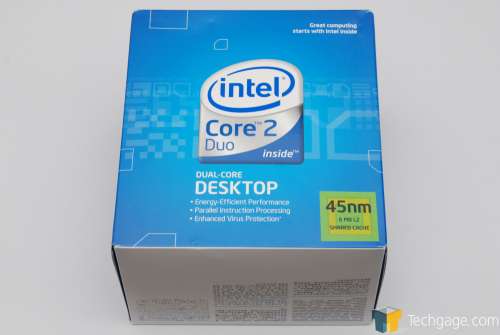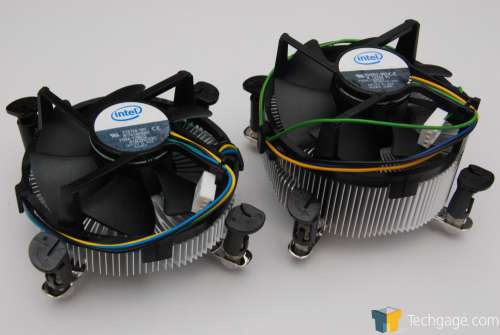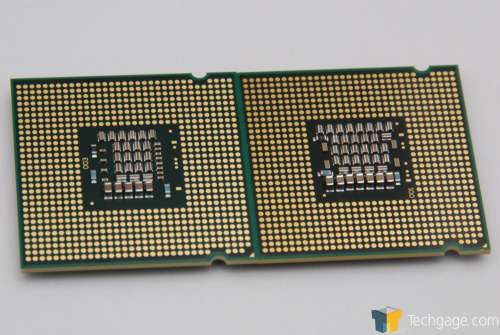- Qualcomm Launches Snapdragon 4 Gen 2 Mobile Platform
- AMD Launches Ryzen PRO 7000 Series Mobile & Desktop Platform
- Intel Launches Sleek Single-Slot Arc Pro A60 Workstation Graphics Card
- NVIDIA Announces Latest Ada Lovelace Additions: GeForce RTX 4060 Ti & RTX 4060
- Maxon Redshift With AMD Radeon GPU Rendering Support Now Available
Intel Core 2 Duo E8400 3.0GHz – Wolfdale Arrives

Intel’s 45nm Dual-Cores have finally arrived, so it’s only fitting that we take one for a spin. Our test subject is the 3.0GHz E8400, offering 6MB cache, SSE4 and more. Overclocking is impressive, with 3.8GHz stable being possible without even raising the voltage! This chip definitely proves itself a winner.
Page 2 – Why Dual Core?, Refreshed Box Art, Stock Cooler
Why Dual-Core?
The computer hardware industry, like many others, moves at an incredible pace. Nineteen months ago when Conroe first launched, the X6800 processor was the ultimate high-end, a Dual-Core offering at 2.93GHz. Indeed, it was a blazing fast processor and with a little overclocking, new heights could be reached. But today, despite that processor still being fast, it seems so mundane when compared to the latest offerings.
One reason that’s the case is that half a year after the X6800, Intel followed up with their high-end QX6700 Quad-Core… effectively opening the gates to the multi-core era. Two months following that, the Q6600 was launched, becoming one of the most popular choices for hardware enthusiasts… which is still the case. That fact was helped even further with summer price-drops, placing the processor at >$300. For anyone who could benefit from a Quad-Core, it almost felt like a steal.
With Quad-Cores so prevalent today, then, are Dual-Core offerings becoming less and less of a wise choice? Consider the fact that regardless of which Dual-Core you choose, a Quad-Core variant is never that much more expensive. But of course, overall single-threaded performance will be lacking. As it stands, while the E8400 retails for around $220, the Q6600 Quad-Core hovers around $280. When the 2.66GHz Q9450 is released, it will retail for around $350.
It all comes down to personal preference and budget at this point. If you are an overclocker, it’s just as easy to purchase a Quad-Core offering and overclock it to 3.0GHz speeds with a sufficient cooler. Right now though, the choices are made even easier, since the Q9xxx 45nm models are not yet available. Purchasing a Q6600 at the current time is less appealing now than it was last year, since the new models are right around the corner.
For those who don’t require the flexibility of a Quad-Core, Dual-Cores still prove to be a great choice. They run fast, run cool and suck less power. As you will see in our overclocking reports in this review, we managed to overclock our $220 E8400 so high, that it became faster than the stock Q6600, at $280. Did I mention that I’m talking about a stable overclock? On air? Just thought I should mention it…
Refreshed Box Art, Low-Profile CPU Cooler
Box art doesn’t matter, at all… or does it? Sure it does, to some degree. The old-school Core 2 non-Extreme box art was a sky-blue color, but with 45nm’s launch comes some even more colorful box art. When I tore this beast out of the box… it felt like summer on a winters day. Well, kind of. Perhaps it was just the excitement of a new CPU, I don’t know.
Other than the box art, not much has changed. The CPU cooler for dual-cores remains the same, with it being at about half-height of the Quad-Core version. During testing, I didn’t use the included cooler because it made more sense to go with something that would improve overclocking. If you have no intentions to overclock, the stock cooler will suffice, but overclockers should always invest a little bit of money into their cooling setup.
Taking a look at the back of the new Dual-Core CPUs reveals a decreased collection of filter caps, which is interesting, because the QX9650 didn’t cut down on many all, when compared to the QX6850, for instance. The Dual-Core counter-parts, however, show a very noticeable decrease. Even before popping it in the machine, we can tell it’s more efficient from that fact alone.
It doesn’t matter much right now, but all launch 45nm Dual-Cores are the C0 revision. If improvements are made, the revision might change, so bear this in mind months down the road if you want to purchase one.
CPU codes are as follows:
- E8190: SLAQR
- E8200: SLAPP
- E8400: SLAPL
- E8500: SLAPK
Yes… the E8190’s code is SLAQR. Hard to make something like that up! With that bit of humor, let’s move right into our testing methodology, followed by our testing results.
Support our efforts! With ad revenue at an all-time low for written websites, we're relying more than ever on reader support to help us continue putting so much effort into this type of content. You can support us by becoming a Patron, or by using our Amazon shopping affiliate links listed through our articles. Thanks for your support!








